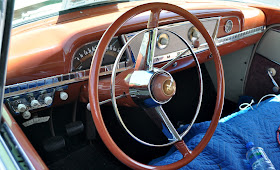Nittler continued on home to nearby Cotulla, Texas, to share this information news with his family. His initial thought was to fix up the old car and then sell it for a profit.
The next day Nittler returned to inspect the Ford with his advisor and consultant, his 9-year-old granddaughter, Jessica. She determined that the antique Ford would be a worthwhile purchase, and with that executive decision made the deal was done.
Nittler had not even had a chance to open the engine hood to see the engine — or to even see if there was an engine. The car was purchased on Father’s Day 2009. Since the Ford sedan was already displayed on a trailer the seller agreed to trailer the car to the buyer’s home.
Paperwork that came with the car indicates that when new it was sold by a Ford dealer in Flatonia, Texas, to a customer in San Antonio. Decades later the car was sold to the man in Dilley from whom it was purchased by Nittler, who is now the third owner of the 61-year-old car.
In 1950 Ford offered a Deluxe line of cars as well as an upscale Custom line with more chrome trim and gadgets. The four-door Ford that Nittler purchased was one of the economy models. That meant there were no armrests on the doors and no horn ring to accent the horn button at the hub of the steering wheel. When new the Ford had a base price of $1,472.
Bright trim surrounding the two-piece windshield and rear window was eliminated. Additionally, the rear vent windows are fixed. Only the vent windows in the front doors are operational.
Beneath the hood is a 226-cubic-inch, six-cylinder engine that develops 95 horsepower. The original owner evidently shunned the 239.4-cubic-inch flathead V-8 engine that produced 100 horsepower.
Below the combination chrome and Plexiglas ornament on the leading edge of the engine hood is the Ford crest, which replaced the chrome letters from the 1949 model that spelled out F O R D.
The bigger engine and additional trim might have been inducements for customers to go upscale but 77,888 bargain hunters in 1950 bought Fords like the one Nittler now has.
His 3,064-pound Ford rides on 6.70×14-inch tires supported by a 114-inch wheelbase. The trunk is deep enough to permit the spare tire to be mounted vertically on the right side of the trunk.
“It’s a pretty basic car,” Nittler says.
In the center of the dashboard is a metal “delete” plate for where the radio would be and one for where the clock would be, too. Under the dashboard is the singular Magic Aire accessory, a heater.
Even the heater is questionable, Nittler says. The heater controls are from a 1949 Ford, which leads him to believe that his car is an early 1950 model and that Ford was simply using up some leftover parts from the 1949 models.
Nittler has now realized that he can never sell the Ford, despite his initial intention to do so. His wife, Aida, has named the Ford “The Tank.” Nittler says, “Once a car has acquired a name it can’t be sold.” — Vern Parker, Motor Matters
Source: askautoexperts.com








